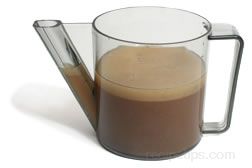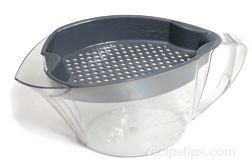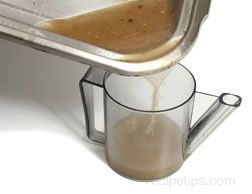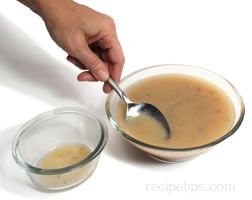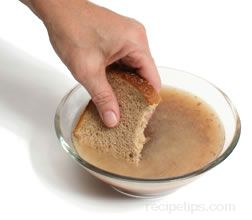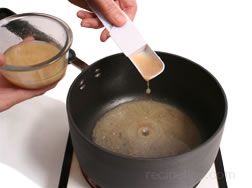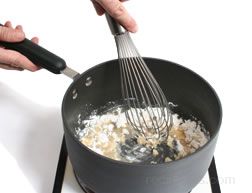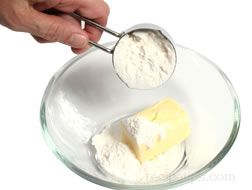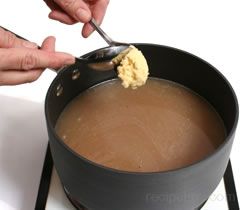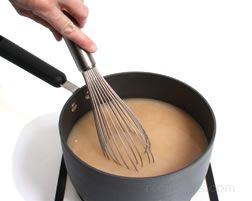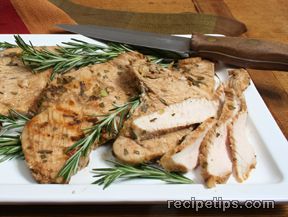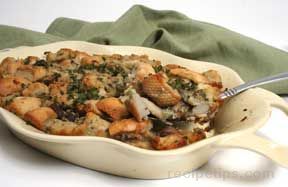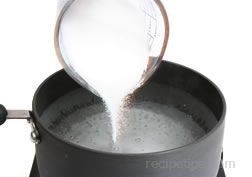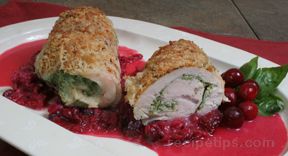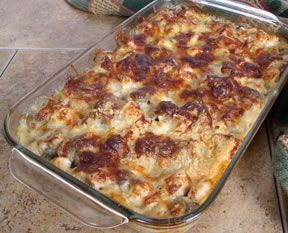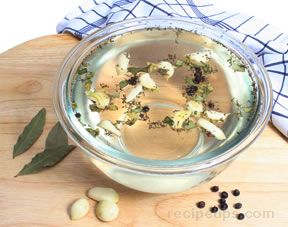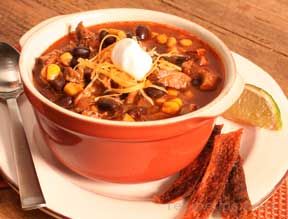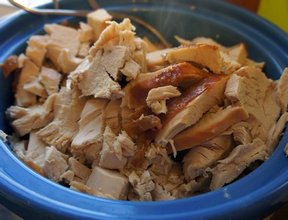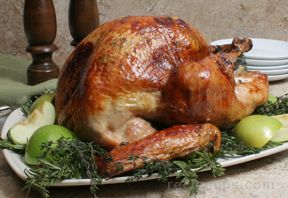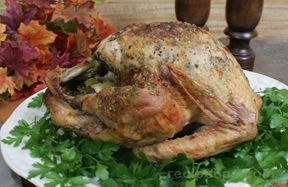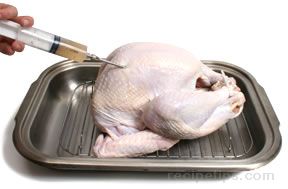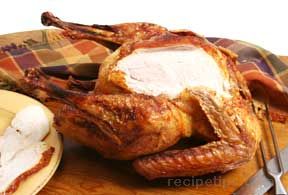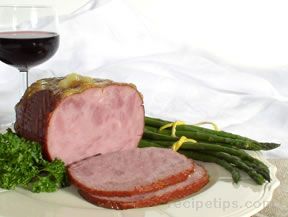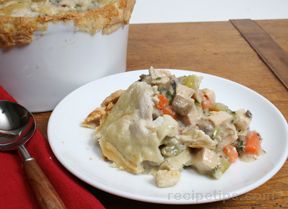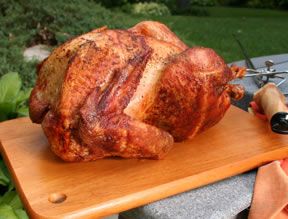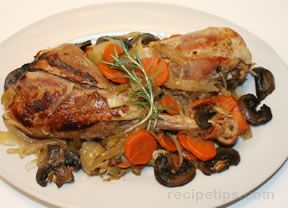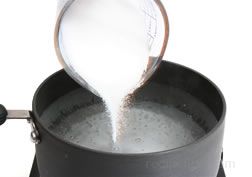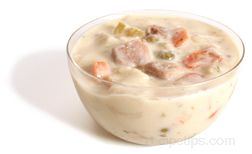Useful Gravy Making Tools | Traditional Methods for Making Gravy
Quick Method for Making Gravy | Adjusting the Consistency | Gravy Making Tips
| There are many recipes available for making turkey gravy, but you will find that most of them call for the use of the turkey drippings and the browned bits from the bottom of the roasting pan (formed as a result of oven roasting the turkey) combined with a small amount of fat, to produce gravy with the best flavor and color. The guidelines described below will help you create smooth, flavorful turkey gravy. |
| There are several tools available that can be used to provide assistance with gravy making. Although these tools are not essential to success in making turkey gravy, they help to make the process easier. |
|
Gravy Separator A gravy separator is a kitchen utensil that is used to separate the fat from the flavorful juices that have collected in the roasting pan while the turkey was cooked. When the hot turkey juice (or any hot meat stock containing fat) is poured into the separator, the fat rises to the top while the meat juices remain on the bottom. The spout extends to the bottom of the device where the meat juice is located, allowing it to be poured out while the fat remains on the top of the separator above the level of the spout opening. This design makes it easy to separate the meat juice from the fat. Besides having the ability to separate the juices and fat, some gravy separator models have a strainer that fits on the top, which filters unwanted particles.
|
|
Whisk A wire whisk works well when combining the fat and flour that forms the thickening agent for the gravy. The whisk is also the best tool for preventing lumps when the cooking liquid is added to the thickener. |
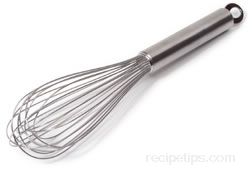 |
|
Strainer The strainer is a good tool for eliminating unwanted particles in broth, pan drippings, and the finished turkey gravy. When the liquid is poured through the mesh of the strainer, the particles are trapped by the strainer because they are too large to flow through the openings in the fine mesh. |
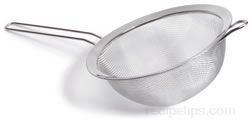 |
Traditional Methods for Making Gravy
|
There are two traditional methods for making turkey gravy (or any other type of gravy) that involve the same initial steps. The primary difference between the two gravy making methods is in the procedure for thickening the gravy. One method uses a roux and the other method uses a beurre manié for thickening. Both are a mixture of flour and fat, but they are prepared differently and are added at different points in the gravy making process. The initial steps for both gravy making methods are: preparing the stock, separating the fat from the meat juices that have collected in the roasting pan while the turkey was cooking, deglazing the roasting pan, and determining the gravy quantity. |
Preparing the Stock | Separating the Fat from the Meat Juices
Deglazing the Roasting Pan | Determining the Gravy Quantity
Thickening the Gravy: Roux | Thickening the Gravy: Beurre Manié
|
Most types of gravy require additional cooking liquid to reach the proper consistency and to ensure that the quantity will be adequate. Homemade stock adds so much flavor to gravy, but it is a step that is not absolutely necessary when preparing gravy. Commercially prepared canned stock can be substituted. Potato water is also a good choice, or plain water may be used if nothing else is available. Homemade stock can be prepared a day ahead and refrigerated until it is needed. When refrigerated, any fat in the stock will rise and harden on the surface, which makes it easy to remove. The steps described below can be used to prepare | |
|
Place the neck, heart, and gizzard in a saucepan and cover with water. Do not use the turkey liver because it will impart a bitter taste to the stock. Add a 1/2 teaspoon of table salt or 1 teaspoon of kosher salt to the saucepan. Cook over high heat until boiling. Note: Vegetables, such as onions, carrots, and celery, can also be used to provide additional flavor. |
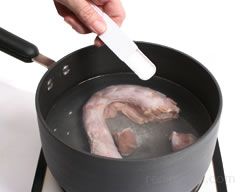 |
| As the stock cooks, foam and impurities will collect on the surface of the liquid. Skim off as much of the foam and impurities as possible and discard. | 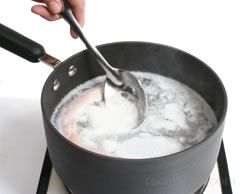 |
| Once the stock begins to boil, cover the saucepan and turn down the heat to low. Allow the stock to simmer for 45 minutes to an hour. | 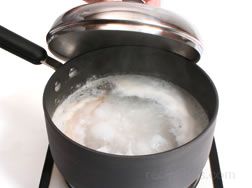 |
|
Remove the giblets from the saucepan and pour the liquid into a bowl. If the stock contains unwanted bits and pieces that have been released from the giblets, you may want to pour the stock through a strainer. Allow the stock to cool slightly and then refrigerate it until it is ready to use. Note: Commercially prepared stock or broth can be used instead of the homemade turkey stock. |
 |
|
Deglazing the roasting pan releases the browned bits from the pan that have collected during the roasting process. These tasty morsels add so much flavor and color to the gravy. If, however, there are few browned bits in the pan after roasting the turkey, an easy remedy is to add a few pieces of skin and some of the meat from the neck or the bottom of the turkey and brown them in the roasting pan prior to deglazing the pan. |
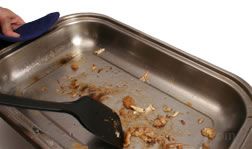 |
| Begin the deglazing process by placing the roasting pan on the stovetop over medium heat. Add 2 cups of stock to the roasting pan. | 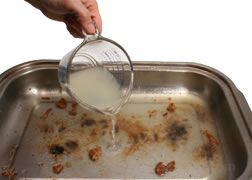 |
| As the contents of the roasting pan are heated, stir the stock and scrape the flavorful bits from the sides and bottom of the pan. |  |
| Pour the deglazed liquid into a gravy separator to separate the fat and juices, or pour the contents into a bowl and skim the fat off the top after the juices have set for several minutes. | 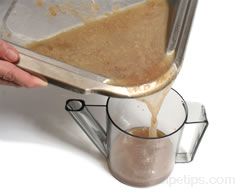 |
| Pour the meat juices through a strainer and into the 2-quart measuring cup containing the other defatted meat juices that were collected earlier (immediately following the roasting process). |  |
| No. of Servings | Cooking Liquid | Flour | Fat (or butter) |
| 6 | 2 cups | 2 Tbsp. | 2 Tbsp. |
| 8 | 2-2/3 cups | 2-2/3 Tbsp. | 2-2/3 Tbsp. |
| 10 | 3-1/3 cups | 3-1/3 Tbsp. | 3-1/3 Tbsp. |
| 12 | 4 cups | 4 Tbsp. | 4 Tbsp. |
| 14 | 4-2/3 cups | 4-2/3 Tbsp. | 4-2/3 Tbsp. |
| 16 | 5-1/3 cups | 5-1/3 Tbsp. | 5-1/3 Tbsp. |
| 18 | 6 cups | 6 Tbsp. | 6 Tbsp. |
| 20 | 6-2/3 cups | 6-2/3 Tbsp. | 6-2/3 Tbsp. |
|
The quick method for gravy making requires that the pan in which the turkey was oven roasted has the versatility to be used on the stovetop as well. This allows some of the steps used for traditional gravy making to be combined. The quick method of gravy making uses a roux for thickening. The fat and flour for the roux are cooked in the roasting pan after the meat juices and fat have been poured off and reserved. To begin the quick method, pour off the meat juices and fat from the roasting pan and separate them as described previously in "Separating the Fat from the Meat Juices." The pan can be deglazed if desired, but this is not necessary for this method. Make sure the cooking liquid is handy. Cooking liquids may consist of juices from pan drippings, homemade stock, broth, potato water, or plain water. Place the roasting pan on the stovetop over medium heat. If the roasting pan is large, it may be necessary to position it over two burners. | |
| Determine amount of fat required for the quantity of gravy being prepared. Use the fat that was separated from the meat juices and pour the required amount into the roasting pan. Refer to the "Determining the Gravy Quantity" chart for calculating the quantity of fat, flour, and cooking liquid required. |  |
| Sprinkle the required amount of flour into the roasting pan and stir it into the fat. Cook the fat and flour mixture (roux) for approximately 2 minutes, stirring constantly. | 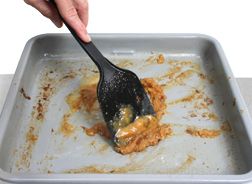 |
|
Pour gradually a 1/2 cup of the cooking liquid into the roasting pan while stirring constantly. Stir quickly to prevent lumps and to combine the flour and fat evenly with the liquid. The mixture will thicken quickly. As the gravy thickens, add more cooking liquid. Pour in approximately a 1/2 cup at a time and stir until it is thoroughly blended into the gravy. Continue to add the cooking liquid in this manner until the all of the required liquid (for the number of desired servings) has been used and the gravy has a smooth consistency. |
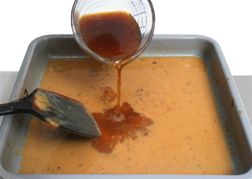 |
| Simmer the gravy for 5 to 10 minutes. After simmering, taste the gravy and adjust the flavor with salt and pepper if necessary. | 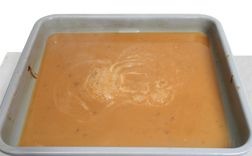 |
| If the gravy contains unwanted particles, pour it through a mesh strainer before serving. Pour the gravy into a serving bowl or gravy boat and serve it while piping hot. |  |
Adjusting the Consistency of the Gravy
|
If the consistency of the gravy is not as desired, there If the Gravy is Too Thick:
If the Gravy is not Thick Enough:
|
|
Preparation and Troubleshooting Tips
Flavor Tips
Safety Tips
|






